alarm FIAT FREEMONT 2014 1.G Owners Manual
[x] Cancel search | Manufacturer: FIAT, Model Year: 2014, Model line: FREEMONT, Model: FIAT FREEMONT 2014 1.GPages: 388, PDF Size: 4.13 MB
Page 21 of 388
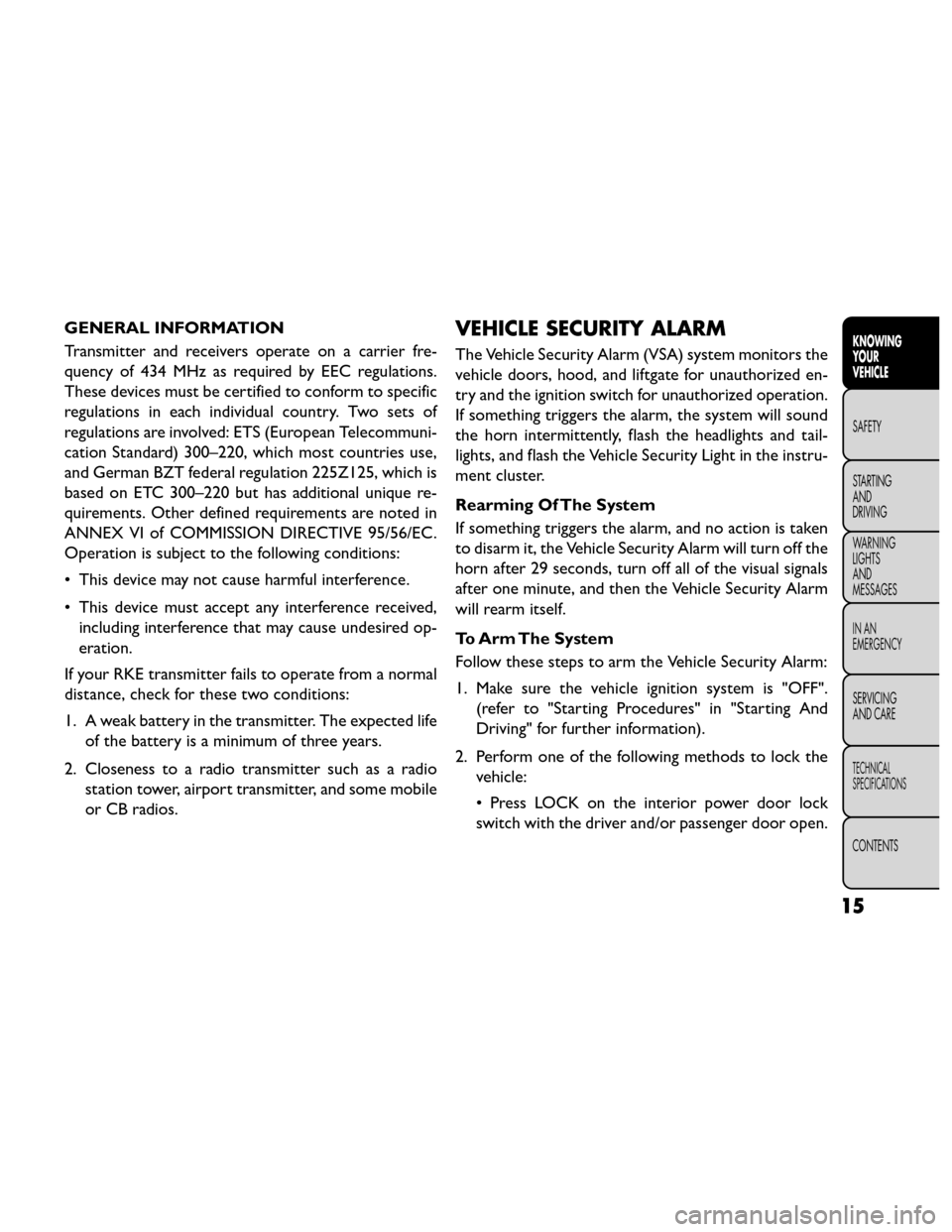
GENERAL INFORMATION
Transmitter and receivers operate on a carrier fre-
quency of 434 MHz as required by EEC regulations.
These devices must be certified to conform to specific
regulations in each individual country. Two sets of
regulations are involved: ETS (European Telecommuni-
cation Standard) 300–220, which most countries use,
and German BZT federal regulation 225Z125, which is
based on ETC 300–220 but has additional unique re-
quirements. Other defined requirements are noted in
ANNEX VI of COMMISSION DIRECTIVE 95/56/EC.
Operation is subject to the following conditions:
• This device may not cause harmful interference.
• This device must accept any interference received,including interference that may cause undesired op-
eration.
If your RKE transmitter fails to operate from a normal
distance, check for these two conditions:
1. A weak battery in the transmitter. The expected life of the battery is a minimum of three years.
2. Closeness to a radio transmitter such as a radio station tower, airport transmitter, and some mobile
or CB radios.VEHICLE SECURITY ALARM
The Vehicle Security Alarm (VSA) system monitors the
vehicle doors, hood, and liftgate for unauthorized en-
try and the ignition switch for unauthorized operation.
If something triggers the alarm, the system will sound
the horn intermittently, flash the headlights and tail-
lights, and flash the Vehicle Security Light in the instru-
ment cluster.
Rearming Of The System
If something triggers the alarm, and no action is taken
to disarm it, the Vehicle Security Alarm will turn off the
horn after 29 seconds, turn off all of the visual signals
after one minute, and then the Vehicle Security Alarm
will rearm itself.
To Arm The System
Follow these steps to arm the Vehicle Security Alarm:
1. Make sure the vehicle ignition system is "OFF".(refer to "Starting Procedures" in "Starting And
Driving" for further information).
2. Perform one of the following methods to lock the vehicle:
• Press LOCK on the interior power door lock
switch with the driver and/or passenger door open.
15
KNOWING
YOUR
VEHICLE
SAFETY
STARTING
AND
DRIVING
W
ARNING
LIGHTS
AND
MESSAGES
IN AN
EMERGENCY
SERVICING
AND CARE
TECHNICAL
SPECIFICATIONS
CONTENTS
Page 22 of 388
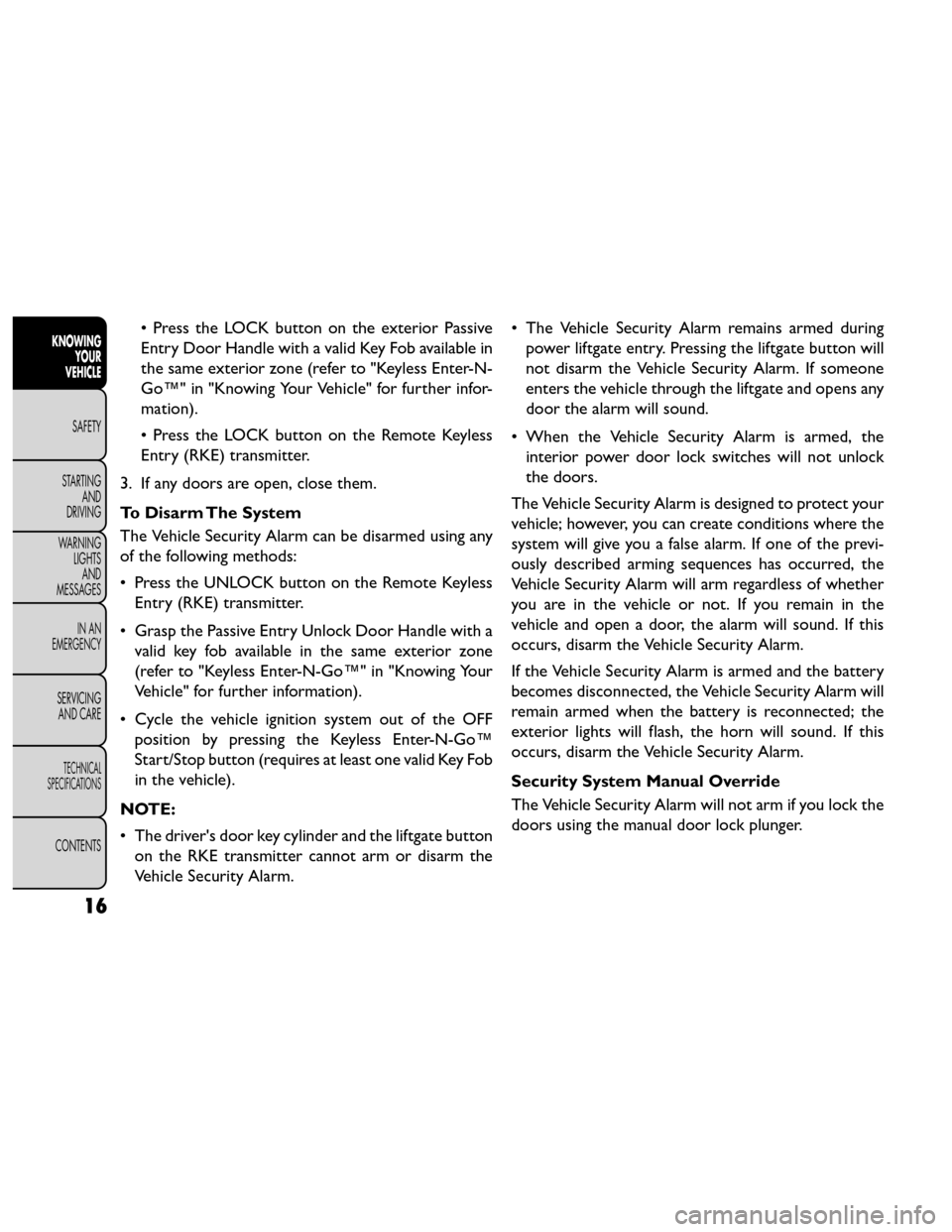
• Press the LOCK button on the exterior Passive
Entry Door Handle with a valid Key Fob available in
the same exterior zone (refer to "Keyless Enter-N-
Go™" in "Knowing Your Vehicle" for further infor-
mation).
• Press the LOCK button on the Remote Keyless
Entry (RKE) transmitter.
3. If any doors are open, close them.
To Disarm The System
The Vehicle Security Alarm can be disarmed using any
of the following methods:
• Press the UNLOCK button on the Remote Keyless Entry (RKE) transmitter.
• Grasp the Passive Entry Unlock Door Handle with a valid key fob available in the same exterior zone
(refer to "Keyless Enter-N-Go™" in "Knowing Your
Vehicle" for further information).
• Cycle the vehicle ignition system out of the OFF position by pressing the Keyless Enter-N-Go™
Start/Stop button (requires at least one valid Key Fob
in the vehicle).
NOTE:
• The driver's door key cylinder and the liftgate button on the RKE transmitter cannot arm or disarm the
Vehicle Security Alarm. • The Vehicle Security Alarm remains armed during
power liftgate entry. Pressing the liftgate button will
not disarm the Vehicle Security Alarm. If someone
enters the vehicle through the liftgate and opens any
door the alarm will sound.
• When the Vehicle Security Alarm is armed, the interior power door lock switches will not unlock
the doors.
The Vehicle Security Alarm is designed to protect your
vehicle; however, you can create conditions where the
system will give you a false alarm. If one of the previ-
ously described arming sequences has occurred, the
Vehicle Security Alarm will arm regardless of whether
you are in the vehicle or not. If you remain in the
vehicle and open a door, the alarm will sound. If this
occurs, disarm the Vehicle Security Alarm.
If the Vehicle Security Alarm is armed and the battery
becomes disconnected, the Vehicle Security Alarm will
remain armed when the battery is reconnected; the
exterior lights will flash, the horn will sound. If this
occurs, disarm the Vehicle Security Alarm.
Security System Manual Override
The Vehicle Security Alarm will not arm if you lock the
doors using the manual door lock plunger.
16
KNOWING YOUR
VEHICLE
SAFETY
STARTING AND
DRIVING
W
ARNING LIGHTS AND
MESSAGES
IN AN
EMERGENCY
SERVICING AND CARE
TECHNICAL
SPECIFICATIONS
CONTENTS
Page 23 of 388
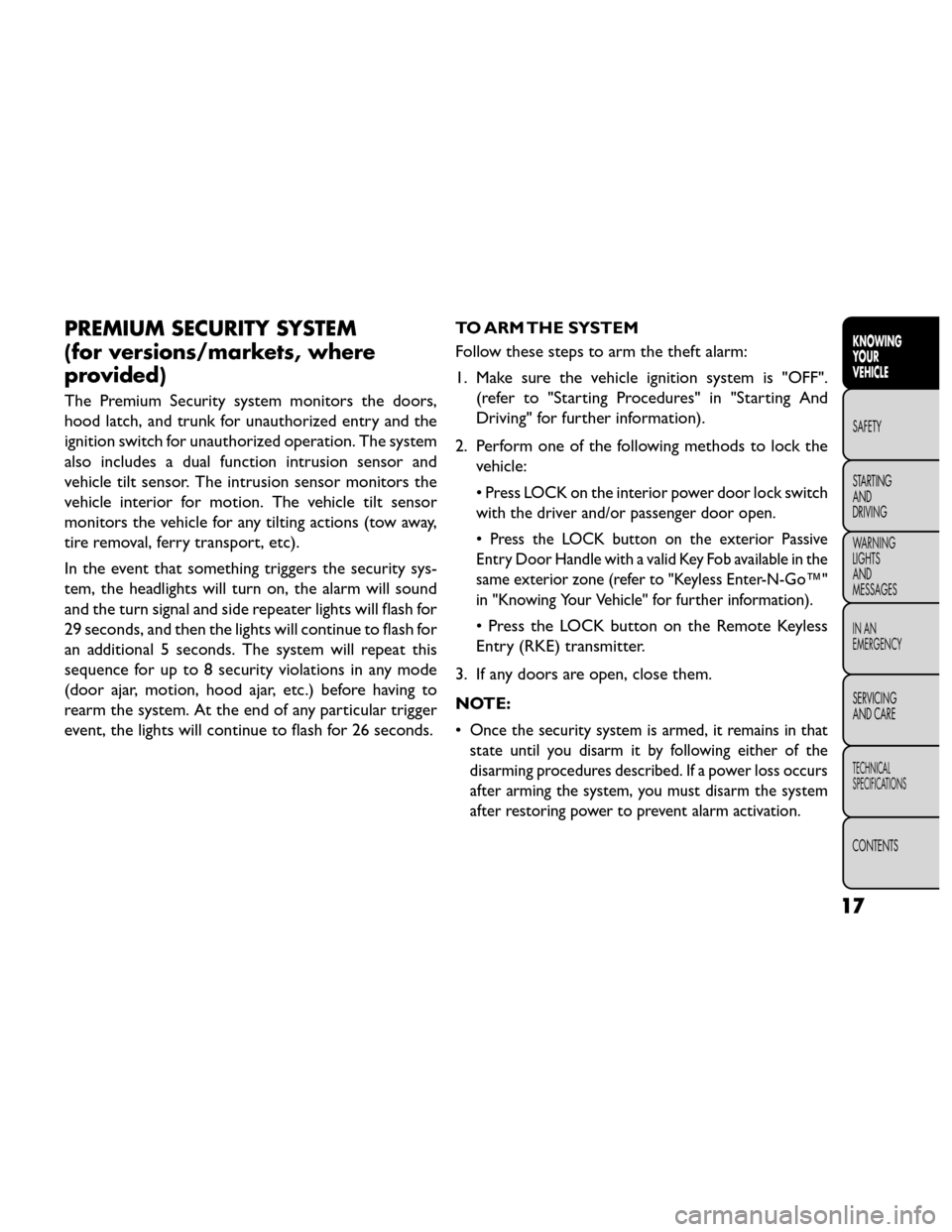
PREMIUM SECURITY SYSTEM
(for versions/markets, where
provided)
The Premium Security system monitors the doors,
hood latch, and trunk for unauthorized entry and the
ignition switch for unauthorized operation. The system
also includes a dual function intrusion sensor and
vehicle tilt sensor. The intrusion sensor monitors the
vehicle interior for motion. The vehicle tilt sensor
monitors the vehicle for any tilting actions (tow away,
tire removal, ferry transport, etc).
In the event that something triggers the security sys-
tem, the headlights will turn on, the alarm will sound
and the turn signal and side repeater lights will flash for
29 seconds, and then the lights will continue to flash for
an additional 5 seconds. The system will repeat this
sequence for up to 8 security violations in any mode
(door ajar, motion, hood ajar, etc.) before having to
rearm the system. At the end of any particular trigger
event, the lights will continue to flash for 26 seconds.TO ARM THE SYSTEM
Follow these steps to arm the theft alarm:
1. Make sure the vehicle ignition system is "OFF".
(refer to "Starting Procedures" in "Starting And
Driving" for further information).
2. Perform one of the following methods to lock the vehicle:
•
Press LOCK on the interior power door lock switch
with the driver and/or passenger door open.
•Press the LOCK button on the exterior Passive
Entry Door Handle with a valid Key Fob available in the
same exterior zone (refer to "Keyless Enter-N-Go™"
in "Knowing Your Vehicle" for further information).
• Press the LOCK button on the Remote Keyless
Entry (RKE) transmitter.
3. If any doors are open, close them.
NOTE:
•
Once the security system is armed, it remains in that
state until you disarm it by following either of the
disarming procedures described. If a power loss occurs
after arming the system, you must disarm the system
after restoring power to prevent alarm activation.
17
KNOWING
YOUR
VEHICLE
SAFETY
STARTING
AND
DRIVING
W
ARNING
LIGHTS
AND
MESSAGES
IN AN
EMERGENCY
SERVICING
AND CARE
TECHNICAL
SPECIFICATIONS
CONTENTS
Page 24 of 388

• The ultrasonic intrusion sensor (motion detector)actively monitors your vehicle every time you arm
the security system. If you prefer, you can turn OFF
the ultrasonic intrusion sensor and vehicle tilt sensor
when arming the security system. To do so, press the
LOCK button on the RKE transmitter three times
within 5 seconds of arming the system (while the
Vehicle Security Light is flashing rapidly).
TO DISARM THE SYSTEM
The Vehicle Security Alarm can be disarmed using any
of the following methods:
• Press the UNLOCK button on the Remote Keyless Entry (RKE) transmitter.
• Grasp the Passive Entry Unlock Door Handle with a valid key fob available in the same exterior zone
(refer to "Keyless Enter-N-Go™" in "Knowing Your
Vehicle" for further information).
• Cycle the vehicle ignition system out of the OFF position by pressing the Keyless Enter-N-Go™
Start/Stop button (requires at least one valid Key Fob
in the vehicle). NOTE:
• The driver's door key cylinder and the trunk button
on the RKE transmitter cannot arm or disarm the
Vehicle Security Alarm.
• When the Vehicle Security Alarm is armed, the interior power door lock switches will not unlock
the doors.
The Vehicle Security Alarm is designed to protect your
vehicle; however, you can create conditions where the
system will give you a false alarm. If one of the previ-
ously described arming sequences has occurred, the
Vehicle Security Alarm will arm regardless of whether
you are in the vehicle or not. If you remain in the
vehicle and open a door, the alarm will sound. If this
occurs, disarm the Vehicle Security Alarm.
If the Vehicle Security Alarm is armed and the battery
becomes disconnected, the Vehicle Security Alarm will
remain armed when the battery is reconnected; the
exterior lights will flash, the horn will sound. If this
occurs, disarm the Vehicle Security Alarm.
SECURITY SYSTEM MANUAL OVERRIDE
The system will not arm if you lock the doors using the
manual door lock plunger.
18
KNOWING YOUR
VEHICLE
SAFETY
STARTING AND
DRIVING
W
ARNING LIGHTS AND
MESSAGES
IN AN
EMERGENCY
SERVICING AND CARE
TECHNICAL
SPECIFICATIONS
CONTENTS
Page 124 of 388

KEYLESS ENTER-N-GO™
The Passive Entry system is an enhancement to the
vehicle’s Remote Keyless Entry (RKE) system and a
feature of Keyless Enter-N-Go™. This feature allows
you to lock and unlock the vehicle’s door(s) without
having to press the RKE transmitter lock or unlock
buttons.
NOTE:
• Passive Entry may be programmed ON/OFF; refer to“Uconnect® Settings” in “Knowing Your Vehicle” for
further information.
• If wearing gloves on your hands, or if it has been raining on the Passive Entry door handle, the unlock
sensitivity can be affected, resulting in a slower re-
sponse time.
• If the vehicle is unlocked by the RKE transmitter or Passive Entry and no door goes ajar within 60 sec-
onds, the vehicle will re-lock and will arm the theft
alarm. To Unlock From The Driver's Side:
With a valid Passive Entry RKE transmitter within
1.5 m of the driver's door handle, grab the driver's
front door handle to unlock the driver's door auto-
matically. The interior door panel lock knob will raise
when the door is unlocked.
(fig. 99)
NOTE:
If “Unlock All Doors 1st Press” is pro-
grammed all doors will unlock when you grab hold of
the driver’s front door handle. To select between
“Unlock Driver Door 1st Press” and “Unlock All
Doors 1st Press”, refer to “Electronic Vehicle Informa-
tion Center (EVIC)/Personal Settings (Customer-
Programmable Features)” in “Knowing Your Vehicle”
for further information.
(fig. 99)
Grabbing The Driver's Door Handle
118
KNOWINGYOUR
VEHICLE
SAFETY
STARTING AND
DRIVING
W
ARNING LIGHTS AND
MESSAGES
IN AN
EMERGENCY
SERVICING AND CARE
TECHNICAL
SPECIFICATIONS
CONTENTS
Page 224 of 388
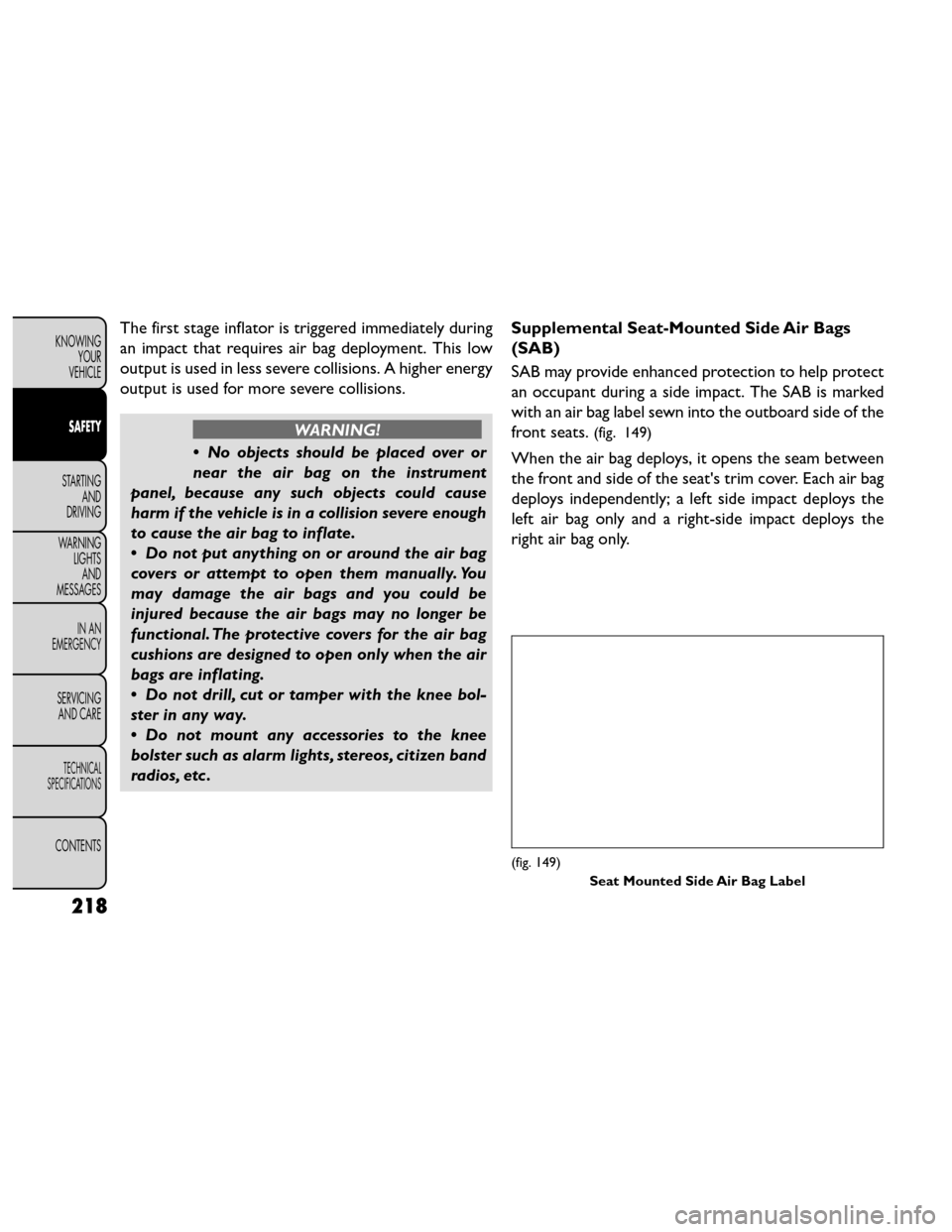
The first stage inflator is triggered immediately during
an impact that requires air bag deployment. This low
output is used in less severe collisions. A higher energy
output is used for more severe collisions.
WARNING!
• No objects should be placed over or
near t
he air bag on the instrument
panel, because any such objects could cause
harm if the vehicle is in a collision severe enough
to cause the air bag to inflate.
• Do not put anything on or around the air bag
covers or attempt to open them manually. You
may damage the air bags and you could be
injured because the air bags may no longer be
functional. The protective covers for the air bag
cushions are designed to open only when the air
bags are inflating.
• Do not drill, cut or tamper with the knee bol-
ster in any way.
• Do not mount any accessories to the knee
bolster such as alarm lights, stereos, citizen band
radios, etc . Supplemental Seat-Mounted Side Air Bags
(SAB)
SAB may provide enhanced protection to help protect
an occupant during a side impact. The SAB is marked
with an air bag label sewn into the outboard side of the
front seats.
(fig. 149)
When the air bag deploys, it opens the seam between
the front and side of the seat's trim cover. Each air bag
deploys independently; a left side impact deploys the
left air bag only and a right-side impact deploys the
right air bag only.
(fig. 149)
Seat Mounted Side Air Bag Label
218
KNOWINGYOUR
VEHICLE
SAFETY
STARTING AND
DRIVING
WARNING LIGHTSAND
MESSAGES
IN AN
EMERGENCY
SERVICING AND CARE
TECHNICAL
SPECIFICATIONS
CONTENTS
Page 275 of 388
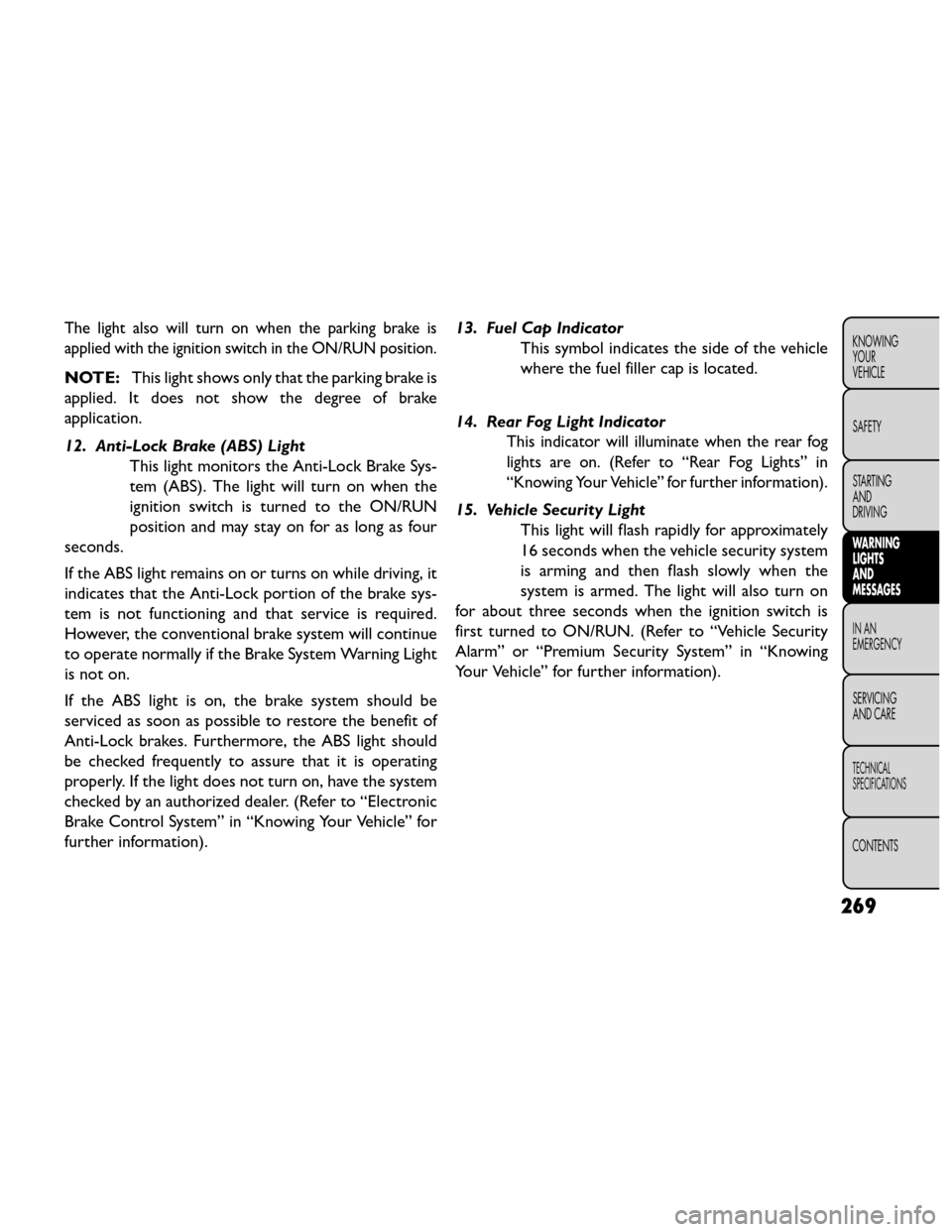
The light also will turn on when the parking brake is
applied with the ignition switch in the ON/RUN position.
NOTE:This light shows only that the parking brake is
applied. It does not show the degree of brake
application.
12. Anti-Lock Brake (ABS) Light This light monitors the Anti-Lock Brake Sys-
tem (ABS). The light will turn on when the
ignition switch is turned to the ON/RUN
position and may stay on for as long as four
seconds.
If the ABS light remains on or turns on while driving, it
indicates that the Anti-Lock portion of the brake sys-
tem is not functioning and that service is required.
However, the conventional brake system will continue
to operate normally if the Brake System Warning Light
is not on.
If the ABS light is on, the brake system should be
serviced as soon as possible to restore the benefit of
Anti-Lock brakes. Furthermore, the ABS light should
be checked frequently to assure that it is operating
properly. If the light does not turn on, have the system
checked by an authorized dealer. (Refer to “Electronic
Brake Control System” in “Knowing Your Vehicle” for
further information). 13. Fuel Cap Indicator
This symbol indicates the side of the vehicle
where the fuel filler cap is located.
14. Rear Fog Light Indicator
This indicator will illuminate when the rear fog
lights are on. (Refer to “Rear Fog Lights” in
“Knowing Your Vehicle” for further information).
15. Vehicle Security Light This light will flash rapidly for approximately
16 seconds when the vehicle security system
is arming and then flash slowly when the
system is armed. The light will also turn on
for about three seconds when the ignition switch is
first turned to ON/RUN. (Refer to “Vehicle Security
Alarm” or “Premium Security System” in “Knowing
Your Vehicle” for further information).
269
KNOWING
YOUR
VEHICLE
SAFETY
STARTING
AND
DRIVING
WARNING
LIGHTS
AND
MESSAGES
IN AN
EMERGENCY
SERVICING
AND CARE
TECHNICAL
SPECIFICATIONS
CONTENTS
Page 374 of 388
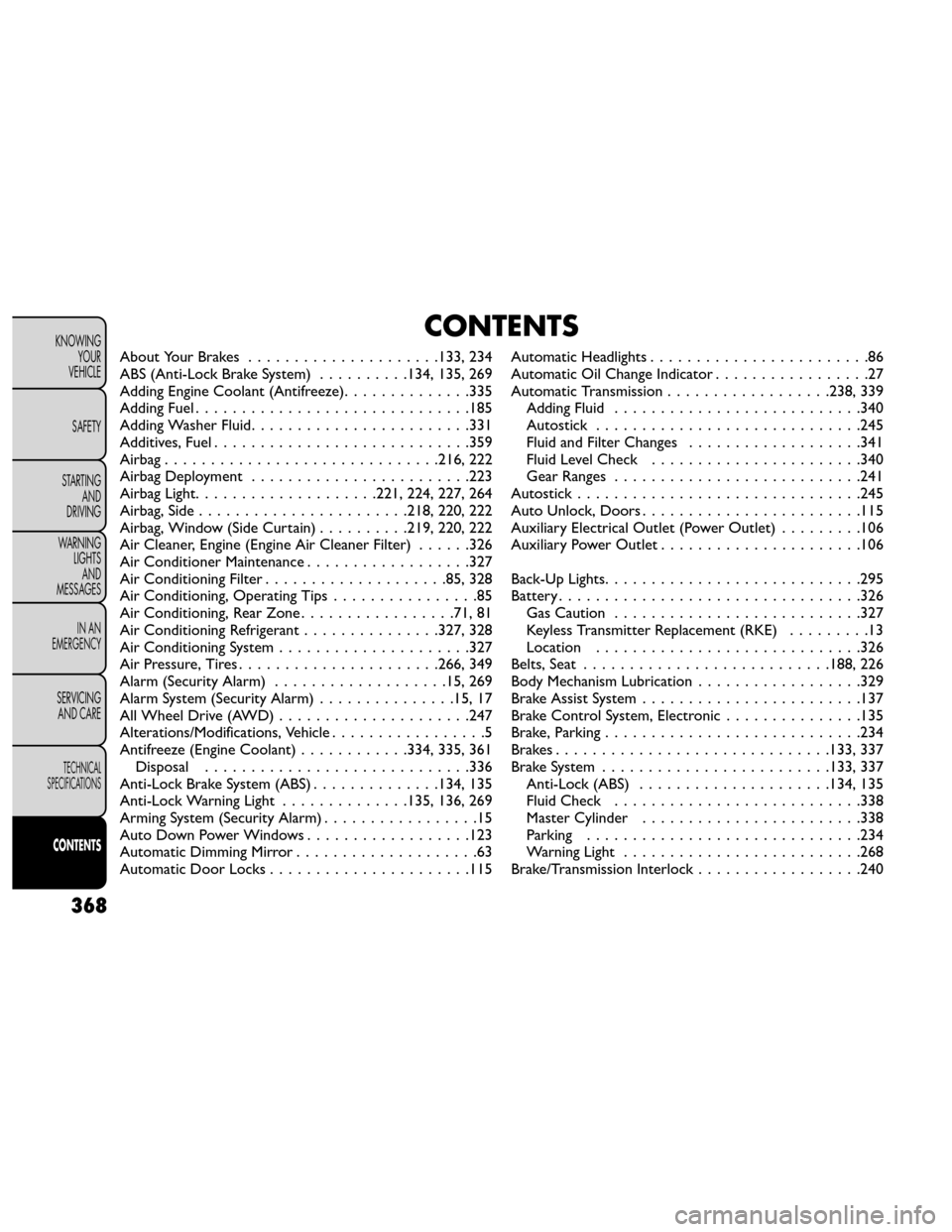
CONTENTS
About Your Brakes..................... 133, 234
ABS (Anti-Lock Brake System) ..........134, 135, 269
Adding Engine Coolant (Antifreeze) ..............335
Adding Fuel ..............................185
Adding Washer Fluid ........................331
Additives, Fuel ............................359
Airbag .............................. 216, 222
Airbag Deployment ........................223
Airbag Light ....................221, 224, 227, 264
Airbag, Side ....................... 218, 220, 222
Airbag, Window (Side Curtain) ..........219, 220, 222
Air Cleaner, Engine (Engine Air Cleaner Filter) ......326
Air Conditioner Maintenance ..................327
Air Conditioning Filter ....................85, 328
Air Conditioning, Operating Tips ................85
Air Conditioning, Rear Zone .................71,81
Air Conditioning Refrigerant ...............327, 328
Air Conditioning System .....................327
Air Pressure, Tires ......................266, 349
Alarm (Security Alarm) ...................15, 269
Alarm System (Security Alarm) ...............15, 17
All Wheel Drive (AWD) .....................247
Alterations/Modifications, Vehicle .................5
Antifreeze (Engine Coolant) ............334, 335, 361
Disposal .............................336
Anti-Lock Brake System (ABS) ..............134, 135
Anti-Lock Warning Light ..............135, 136, 269
Arming System (Security Alarm) .................15
Auto Down Power Windows ..................123
Automatic Dimming Mirror ....................63
Automatic Door Locks ......................115 Automatic Headlights
........................86
Automatic Oil Change Indicator .................27
Automatic Transmission .................. 238, 339
Adding Fluid ...........................340
Autostick .............................245
Fluid and Filter Changes ...................341
Fluid Level Check .......................340
Gear Ranges ...........................241
Autostick ..............................
.245
Auto Unlock, Doors ........................115
Auxiliary Electrical Outlet (Power Outlet) .........106
Auxiliary Power Outlet ......................106
Back-Up Lights ............................295
Battery .................................326
Gas Caution ...........................327
Keyless Transmitter Replacement (RKE) .........13
Location .............................326
Belts, Seat ........................... 188, 226
Body Mechanism Lubrication ..................329
Brake Assist System ........................137
Brake Control System, Electronic ...............135
Brake, Parking ............................234
Brakes ..............................133, 337
Brake System ......................... 133, 337
Anti-Lock (ABS) .....................134, 135
Fluid Check ...........................338
Master Cylinder ........................338
Parking ..............................234
Warning Light ..........................268
Brake/Transmission Interlock ..................240
368
KNOWING
YOUR
VEHICLE
SAFETY
STARTING AND
DRIVING
WARNING LIGHTSAND
MESSAGES
IN AN
EMERGENCY
SERVICING AND CARE
TECHNICAL
SPECIFICATIONS
CONTENTS
Page 382 of 388

Rocking Vehicle When Stuck..................304
Roof Rack (Luggage Rack) ....................132
Rotation, Tires ............................347
Safety Checks Inside Vehicle ...................226
Safety Checks Outside Vehicle .................228
Safety, Exhaust Gas .....................125, 226
Safety Tips ..............................225
Schedule, Maintenance ......................311
Seat Belt Maintenance .......................346
Seat Belt Reminder .........................198
Seat Belts ........................ 187, 188, 226
Adjustable Upper Shoulder Anchorage .........191
And Pregnant Women ....................198
Child Restraint .........................199
Front Seat .........................188, 189
Inspection ............................226
Operating Instructions ....................189
Pretensioners ..........................192
Rear Seat .............................188
Reminder .............................267
Untwisting Procedure ....................192
Seats ...................................45
Adjustment ............................45
Easy Entry .............................57
Heated ...............................46
Height Adjustment .....................45, 50
Power ................................45
Rear Folding .........................54, 58
Reclining ..............................49
Reclining Rear ........................56, 58
Seatback Release ....................50, 54, 58
Tilting ................................45 Security Alarm
.........................15, 269
Selection of Coolant (Antifreeze) ........334, 335, 362
Sentry Key (Immobilizer) ......................11
Sentry Key Programming ......................12
Sentry Key Replacement ......................11
Service Engine Soon Light (Malfunction Indicator) ....264
Shift Lever Override ........................303
Shoulder Belts ............................188
Shoulder Belt Upper Anchorage ................191
Side Airbag ..............................22
2
Side Repeater Lights ........................295
Side View Mirror Adjustment ...................64
Signals, Turn ....................88, 228, 265, 295
Snow Chains (Tire Chains) ....................357
SnowTires..............................352
Sound Systems ............................161
Sound Systems (Radio) ......................161
Spare Tire ........................275, 353, 354
Spark Plugs ..............................362
Specifications Fuel (Gasoline) .........................362
Oil .................................362
Speed Control (Cruise Control) .................96
Speedometer ..............................7
Starting ................................229
Cold Weather .........................231
Engine Fails to Start ......................231
Starting and Operating ......................229
Starting Procedures ........................229
Steering Column Controls ........................88
Column Lock ...........................60
Power ...............................144
376
KNOWING YOUR
VEHICLE
SAFETY
STARTING AND
DRIVING
WARNING LIGHTSAND
MESSAGES
IN AN
EMERGENCY
SERVICING AND CARE
TECHNICAL
SPECIFICATIONS
CONTENTS
Page 384 of 388
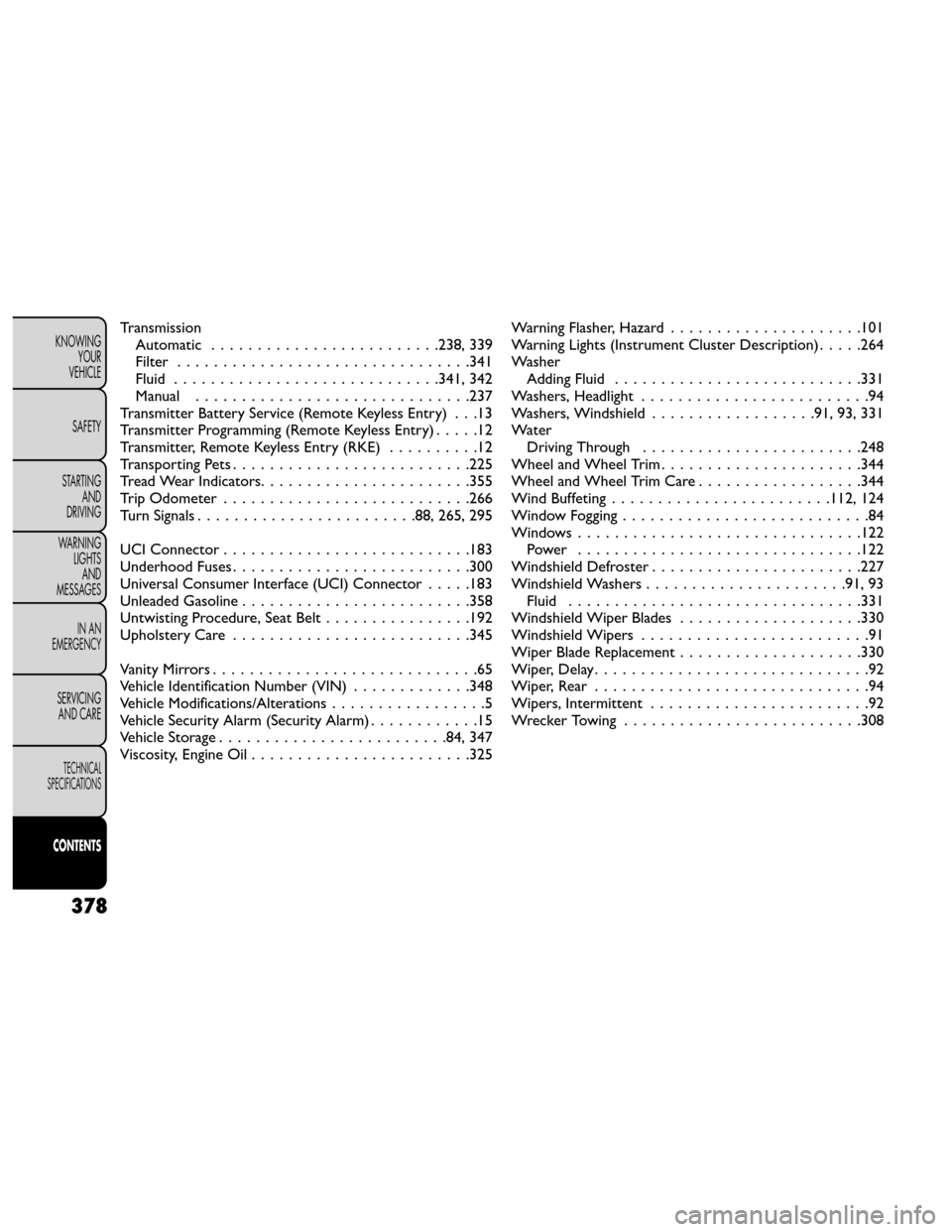
TransmissionAutomatic .........................238, 339
Filter ................................341
Fluid .............................341, 342
Manual ..............................237
Transmitter Battery Service (Remote Keyless Entry) . . .13
Transmitter Programming (Remote Keyless Entry) .....12
Transmitter, Remote Keyless Entry (RKE) ..........12
Transporting Pets ..........................225
Tread Wear Indicators .......................355
TripOdometer ...........................266
Turn Signals ........................88, 265, 295
UCI Connector ...........................183
Underhood Fuses ..........................300
Universal Consumer Interface (UCI) Connector .....183
Unleaded Gasoline .........................358
Untwisting Procedure, Seat Belt ................192
Upholstery Care ..........................345
Vanity Mirrors .............................65
Vehicle Identification Number (VIN) .............348
Vehicle Modifications/Alterations .................5
Vehicle Security Alarm (Security Alarm) ............15
Vehicle Storage .........................84, 347
Viscosity, Engine Oil ........................325 Warning Flasher, Hazard
.....................101
Warning Lights (Instrument Cluster Description) .....264
Washer Adding Fluid ...........................331
Washers, Headlight .........................94
Washers, Windshield ..................91,93,331
Wa te r Driving Through ........................248
Wheel and Wheel Trim ......................344
Wheel and Wheel Trim Care ..................344
Wind Buffeting ........................ 112, 124
Window Fogging ...........................84
Windows...............................122 Power ...............................122
Windshield Defroster .......................227
Windshield Washers ......................91, 93
Fluid ................................331
Windshield Wiper Blades ....................330
Windshield Wipers .........................91
Wiper Blade R
eplacement ....................330
Wiper,Delay..............................92
Wiper,Rear ..............................94
Wipers, Intermittent ........................92
WreckerTowing ..........................308
378
KNOWING YOUR
VEHICLE
SAFETY
STARTING AND
DRIVING
WARNING LIGHTSAND
MESSAGES
IN AN
EMERGENCY
SERVICING AND CARE
TECHNICAL
SPECIFICATIONS
CONTENTS